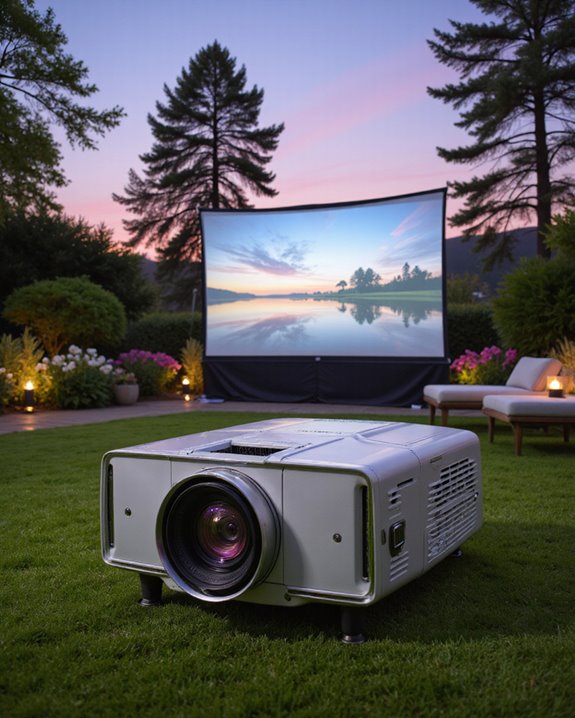When choosing an outdoor projector, prioritize high brightness—at least 3000 lumens, which measures light output, for clear daytime viewing. Resolution should be full HD (1080p) or higher for sharp images. Make certain of durability with weather-resistant features, such as water and dust protection. Built-in speakers (minimum of 10 watts) aid audio clarity, while portability factors—like a lightweight body and carrying case—make setup easier. Multiple input ports expand connectivity. More useful considerations address placement, screen size, and audio upgrades.
Key Takeaways
- Choose a projector with at least 3000 lumens brightness for clear images in daylight or well-lit outdoor environments.
- Select a model with 1080p or higher resolution and strong contrast for sharp, vibrant image quality on large screens.
- Ensure the projector is lightweight, portable, and easy to set up, with features like carrying handles and quick-adjust stands.
- Look for weather-resistant features and durable construction to withstand outdoor conditions and prolonged use.
- Opt for built-in powerful speakers or audio outputs for clear sound, and multiple ports for flexible device connections.
Brightness and Lumen Requirements
Selecting the correct brightness for an outdoor projector is essential for achieving clear and vivid images. Brightness is measured in lumens, a unit indicating the intensity of projected light. Proper lumens calibration helps guarantee that images remain visible under various ambient light conditions. Outdoor settings often have higher ambient light, such as sunlight or streetlights, which can wash out images if the projector is not bright enough. Key guidelines include:
- For daytime use, at least 3000 lumens is recommended.
- Nighttime or low-light environments may only need 2000-2500 lumens.
- Larger screens or large audiences require projectors with 4000 lumens or more.
- Additionally, choosing weather-resistant screens can help improve image clarity during outdoor use in varying conditions.
To select the appropriate projector, users should assess ambient light, screen size, and event type. Carefully balancing these factors ensures clear outdoor viewing.
Resolution and Image Quality
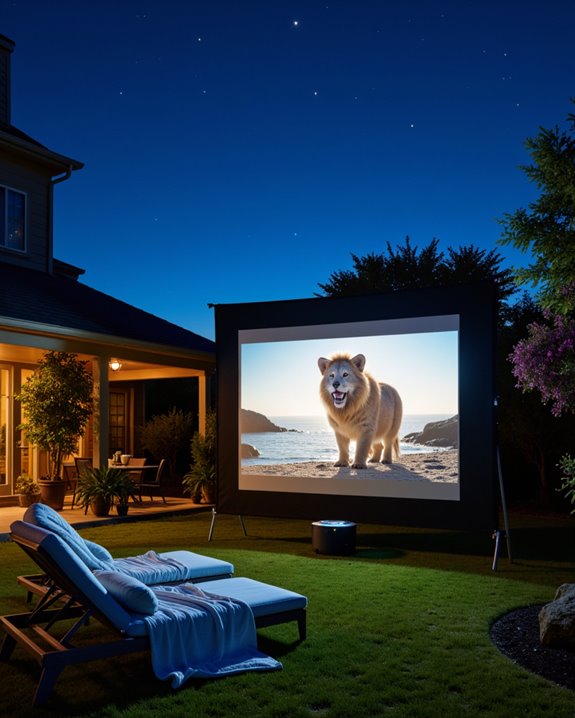
A projector’s resolution and image quality play a critical role in creating a sharp and engaging outdoor viewing experience. Resolution refers to the number of pixels in an image; higher resolutions like 1080p or 4K offer greater detail than 720p models. For outdoor use, 1080p is often recommended due to its balance of clarity and cost. However, 4K projectors provide even sharper visuals when paired with high-quality content resolution, though they are more expensive. Color accuracy, or the projector’s ability to reproduce true-to-life colors, is essential for vibrant images, especially outdoors. Key image quality factors include:
- Pixel density: Higher density means sharper images.
- Contrast ratio: Impacts dark and light detail.
- HDR support: Improves color accuracy and dynamic range.
Screen Size and Viewing Distance
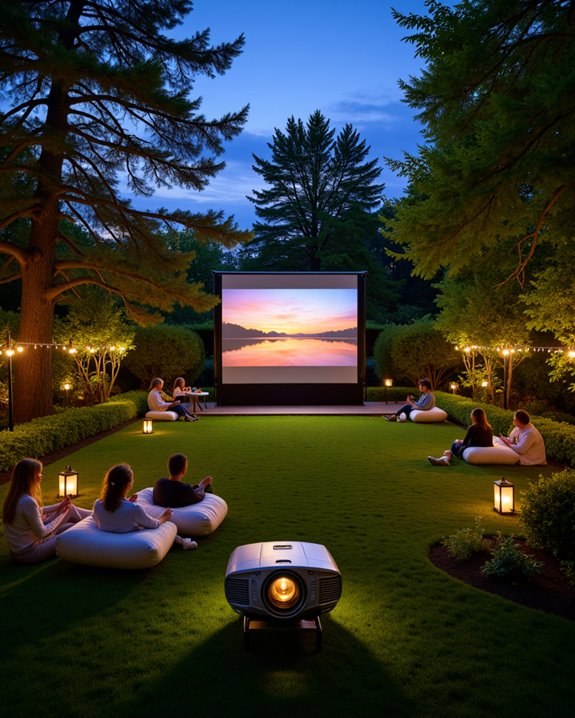
Choosing the right screen size and viewing distance is essential for creating a comfortable and visually engaging outdoor projector setup. Larger screens, such as 100 or 120 inches, increase immersion but demand more space and careful light control. The screen aspect ratio, often 16:9, should match the projector for proper image fit. Viewing angle, the width of the image seen from a specific seat, should meet SMPTE’s 30-degree or THX’s 26-degree recommendations for best clarity. Additionally, selecting a high-resolution projector ensures crisp images at larger sizes, enhancing your outdoor viewing experience. Key considerations include: – Minimum viewing distance: three times screen height – Maximum distance: three to six times screen width – Screen materials: polyester, vinyl, or inflatable options – Use calculators or charts to find ideal placement Maintaining proper distance ensures clear, undistorted visuals for every viewer in an outdoor setting.
Portability and Battery Life
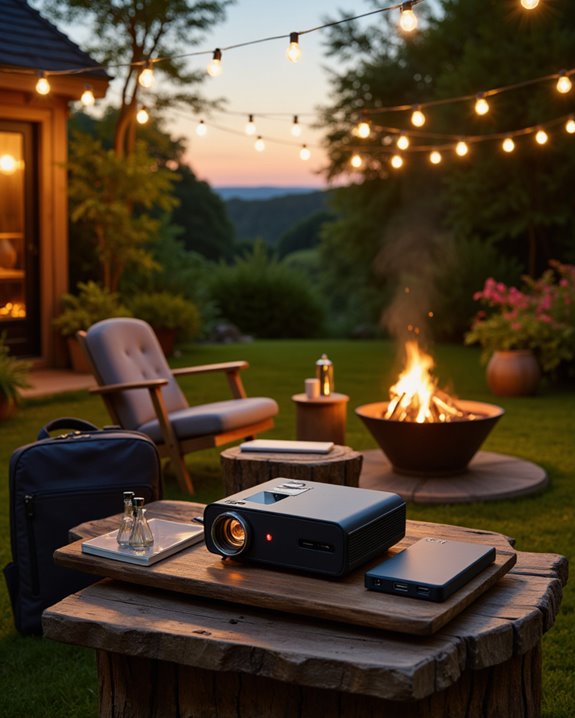
When evaluating outdoor projectors, portability and battery life emerge as essential factors, especially for users planning events in varied locations. A portable design means the projector is lightweight, often under 30 pounds, and compact enough for easy transport. Many models include integrated handles and carrying cases, simplifying storage and movement. Quick setup features, such as included tripod stands and adjustable screens, ensure adaptability in different settings. Battery longevity refers to how long a projector can run on its built-in rechargeable battery—some, like the AAXA M7, offer up to 3 hours of use. Key features to consider include:
- Dual power options (battery and AC)
- Battery life indicators
- Multiple charging methods (USB-C or AC plugs)
Extended battery life and external power compatibility maximize usability for outdoor projection needs.
Built-in Speakers and Audio Options
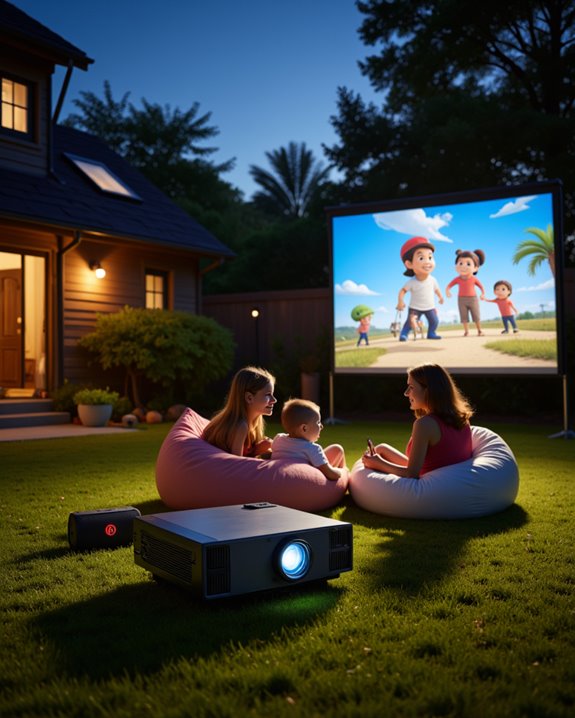
Built-in speakers and audio options play a crucial role in the overall effectiveness of outdoor projectors, as clear and powerful sound is necessary for enjoyable viewing experiences outside. Audio clarity depends on both speaker power and speaker placement, with options ranging from basic 4-watt mono speakers to advanced 40-watt stereo systems like the Mars 3. Technologies such as Dolby Digital Plus and collaborations with brands like Harman Kardon further improve sound quality. Outdoor projector speakers often use special designs, including 270-degree sound coverage and weather-resistant features, to deliver consistent performance in changing conditions. Key features include:
- Volume control for adjusting to outdoor noise
- Audio jacks for connecting external speakers
- Bluetooth compatibility for wireless audio
Speaker durability and user reviews also highlight differences in long-term audio quality.
Connectivity and Input Ports
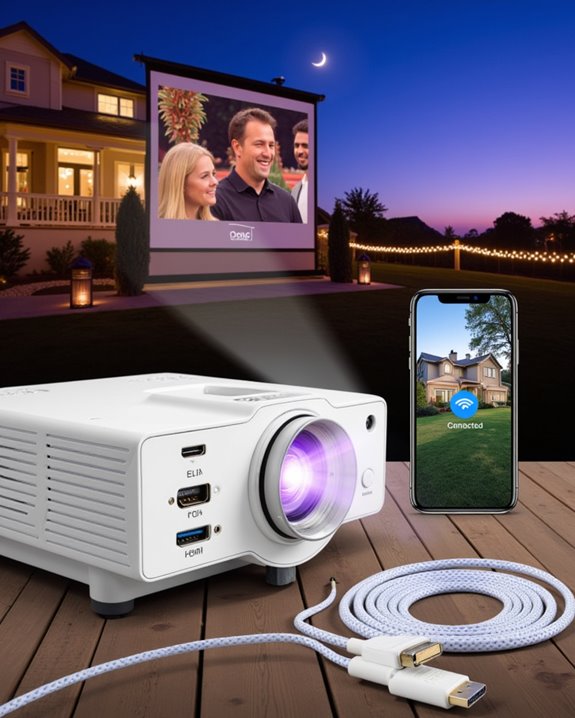
How do outdoor projectors connect to all the devices people use today? Modern outdoor projectors support a wide range of connectivity standards. HDMI ports deliver high-resolution video from gaming consoles, laptops, and streaming devices. USB Type-A ports make it easy to play media files directly from flash drives. Wireless streaming is a key feature, with Wi-Fi integration enabling content mirroring and direct streaming from popular apps. Bluetooth connectivity allows for wireless audio or device pairing. Additional options include:
- USB-C with DisplayPort Alt Mode for newer smartphones and laptops,
- Ethernet (LAN) ports for stable wired internet,
- VGA for older computers,
- Audio outputs for external speakers.
Smart features like Android TV, Chromecast, and Apple AirPlay compatibility further expand wireless streaming and device support, ensuring versatile connectivity for outdoor use.
Outdoor Durability and Weather Resistance
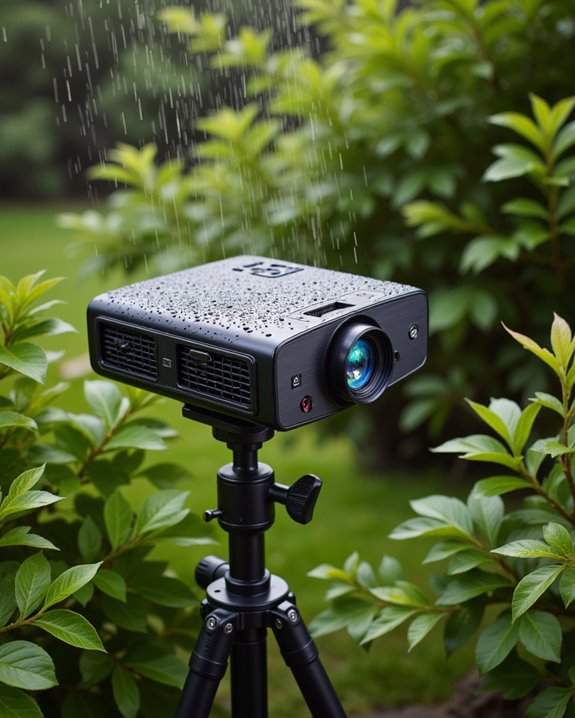
Outdoor projectors must withstand exposure to a wide range of weather conditions. Durability begins with a high Ingress Protection (IP) rating, such as IP55 for the body—meaning resistance to dust and water—and IP68 for connectors, which provides total dust-tightness and protection when immersed in water. Weatherproof coatings are essential; these specialized materials shield sensitive electronics from rain, snow, and direct sunlight. Vandal resistant enclosures, which are heavy-duty protective housings, help deter theft and physical damage. Additional features include:
- Sealed construction to keep out dust and moisture
- Integrated cooling systems to manage temperature extremes (from -20°C to 45°C)
- UV protection to prevent sunlight damage
- Secure mounting to resist high winds
- Certifications for harsh outdoor use
These elements guarantee reliable performance and long-term projector longevity.
Compatibility With Streaming and Gaming
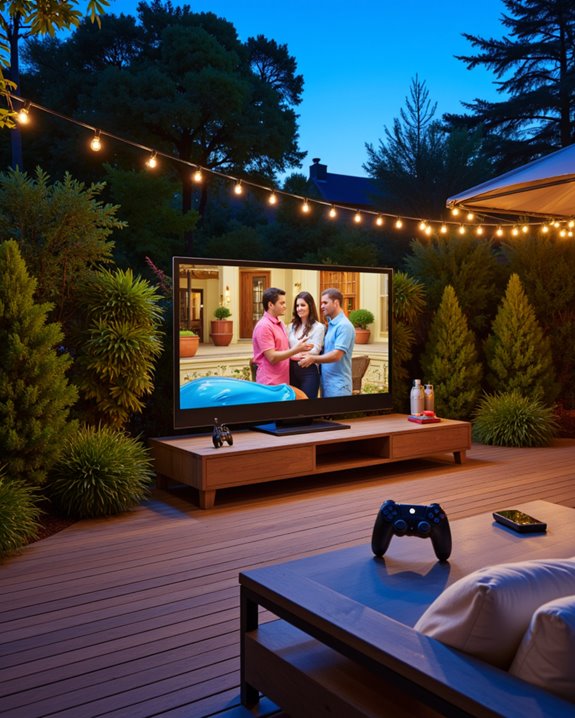
When selecting an outdoor projector, compatibility with streaming and gaming is a vital factor for most users. Native streaming apps—such as Netflix, YouTube, and Amazon Prime Video—allow direct content access without extra devices. Smart projectors equipped with Wi-Fi and Bluetooth support both streaming platforms and wireless audio connections, making outdoor setups more convenient. Reliable dual-band Wi-Fi (2.4GHz/5GHz) ensures smooth streaming, while USB or HDMI ports offer backup when networks are unstable. For gaming, low gaming latency—meaning minimal delay between controller input and screen action—is essential. HDMI 2.0 or higher and variable refresh rate (VRR) support enhance visual performance for consoles. Additional features:
- Built-in memory for buffering reduces streaming interruptions.
- Bluetooth and Wi-Fi Direct connect gaming peripherals wirelessly.
- Full HD (1080p) resolution is recommended for both uses.
Budget and Value Considerations
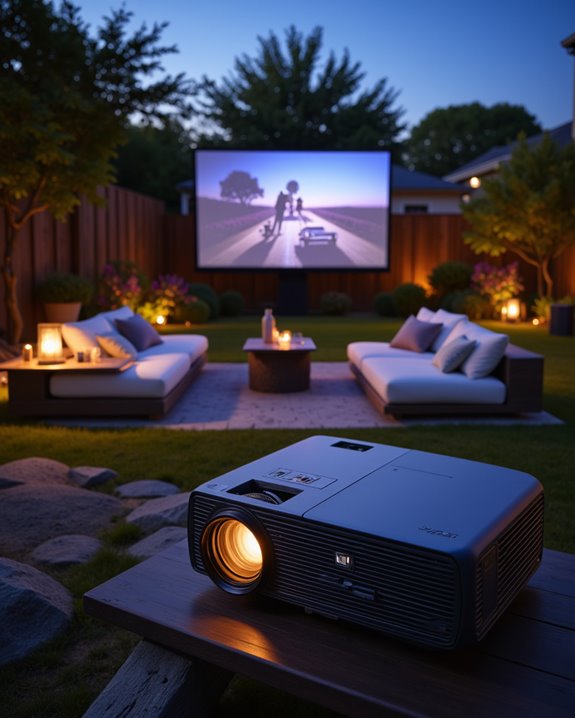
While choosing an outdoor projector, understanding budget and value is essential to making a smart investment. Pricing strategies vary widely: budget projectors ($300–$500) offer 1080p resolution and 800 lumens, but typically require a constant power source. Mid-range models ($500–$1,000) include features like battery power, Bluetooth, and higher brightness, making them more versatile. Premium projectors ($1,000–$2,000) provide native 4K, enhanced color, and longer battery life, while the most expensive options exceed $2,000, focusing on superior image quality and advanced HDR (High Dynamic Range, which improves contrast and color). Brand reputation also plays a role; trusted brands like Epson or BenQ often offer better support and reliability. Buyers must weigh cost against features, portability, and expected longevity.
Additional Features and Customization Options
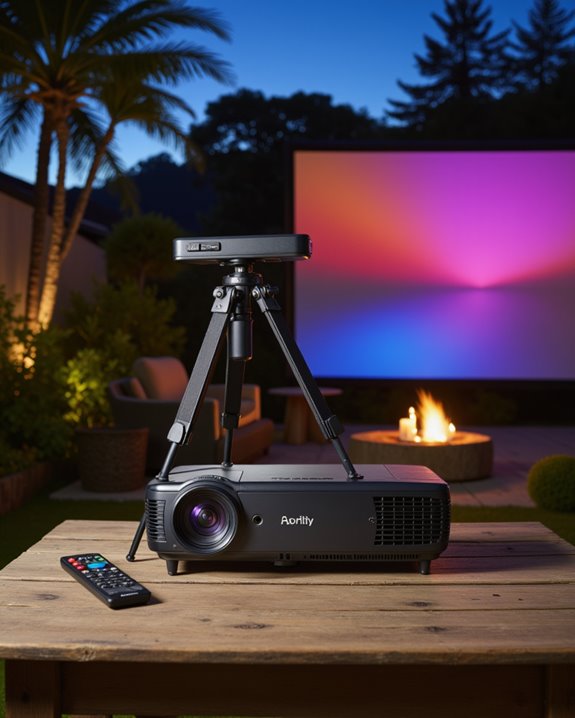
A range of additional features and customization options set modern outdoor projectors apart, directly impacting ease of use, durability, and viewing quality. Water and dust resistance, often rated as IPX3, helps projectors withstand various weather conditions. Built-in stands and integrated carry handles make transportation and setup easier. Protective lens covers help prevent damage from dust or debris. Projectors with robust built-in speakers—sometimes up to 40 watts—offer strong audio, while Bluetooth and HDMI connections allow for flexible device pairing. Optical filters, which are accessories that modify light passage to enhance image quality or adjust image size, provide further customization. Creative lighting, such as integrated camping lights, can add useful ambient light for nighttime viewing. Multiple HDMI and USB ports support various devices, increasing versatility.
Frequently Asked Questions
How Do I Set up an Outdoor Projector for Backyard Movie Nights?
To set up an outdoor projector for backyard movie nights, one arranges appropriate projection placement facing a high-gain screen, completes audio setup with quality speakers, makes certain of ample power supply, positions comfortable seating, and manages lighting and weather precautions.
What Type of Projector Screen Works Best Outdoors?
Like a ship’s sail catching the evening breeze, portable screens with weather resistant surfaces work best outdoors, offering flexibility and durability. Inflatable or free-standing designs are popular, ensuring easy setup and resilience against unpredictable outdoor conditions.
Can I Use an Indoor Projector Outside Temporarily?
Using an indoor projector outside temporarily is feasible if portable options are chosen and the indoor setup is adapted to outdoor conditions. Users should consider brightness, weather protection, and environmental factors to guarantee ideal performance and equipment safety.
How Do I Minimize Bugs Attracted to the Projector Light?
Bugs swarm projector lights like moths to a blazing sun, so minimizing attraction involves using yellow bulbs, positioning light away from people, employing bug repellent, installing light traps, and maintaining cleanliness to deter relentless insect invaders.
Are There Safe Ways to Mount or Secure a Projector Outside?
Safe outdoor projector installation involves selecting appropriate mounting options, such as VESA-compatible adjustable mounts secured to ceiling joists. Security measures include using weatherproof enclosures, locking mechanisms, and sturdy materials to protect against theft, weather, and accidental falls.

